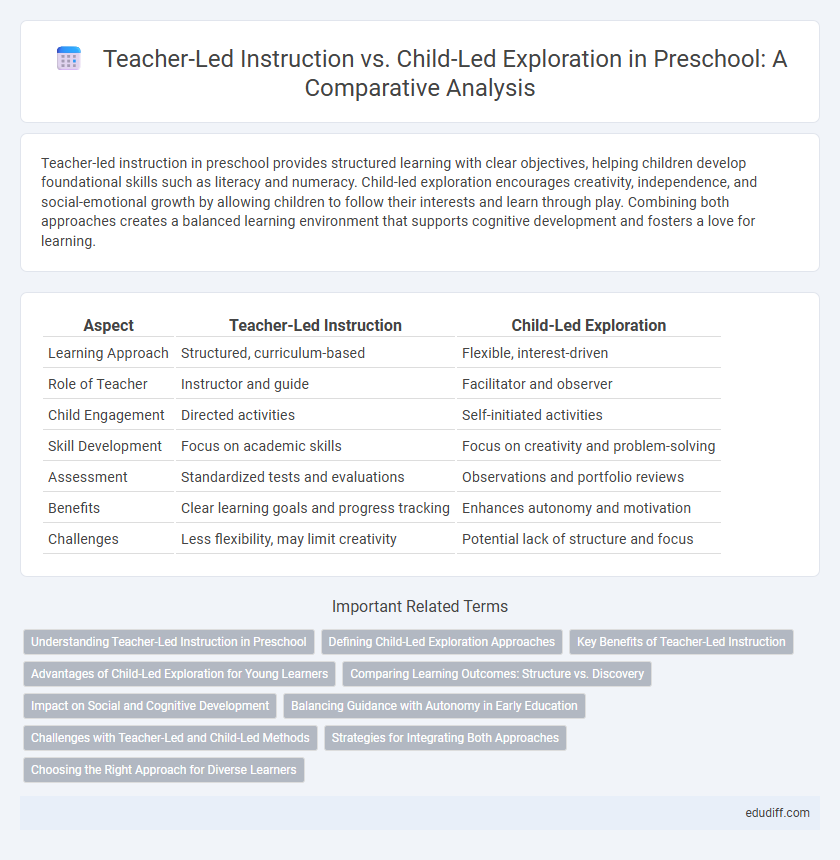Teacher-led instruction in preschool provides structured learning with clear objectives, helping children develop foundational skills such as literacy and numeracy. Child-led exploration encourages creativity, independence, and social-emotional growth by allowing children to follow their interests and learn through play. Combining both approaches creates a balanced learning environment that supports cognitive development and fosters a love for learning.
Table of Comparison
| Aspect | Teacher-Led Instruction | Child-Led Exploration |
|---|---|---|
| Learning Approach | Structured, curriculum-based | Flexible, interest-driven |
| Role of Teacher | Instructor and guide | Facilitator and observer |
| Child Engagement | Directed activities | Self-initiated activities |
| Skill Development | Focus on academic skills | Focus on creativity and problem-solving |
| Assessment | Standardized tests and evaluations | Observations and portfolio reviews |
| Benefits | Clear learning goals and progress tracking | Enhances autonomy and motivation |
| Challenges | Less flexibility, may limit creativity | Potential lack of structure and focus |
Understanding Teacher-Led Instruction in Preschool
Teacher-led instruction in preschool emphasizes structured learning environments where educators guide children through specific activities designed to develop foundational skills in literacy, numeracy, and social interaction. This approach leverages carefully planned lessons to scaffold young learners' cognitive and emotional growth, ensuring consistent developmental milestones are met. Research indicates that teacher-led models provide essential routines and clear expectations that support early childhood learning outcomes effectively.
Defining Child-Led Exploration Approaches
Child-led exploration approaches in preschool prioritize the natural curiosity and interests of children, allowing them to guide their own learning through play and discovery. This method fosters cognitive development, creativity, and problem-solving skills by encouraging children to interact with their environment at their own pace. Key strategies include open-ended activities, sensory experiences, and flexible learning spaces that support independent decision-making and intrinsic motivation.
Key Benefits of Teacher-Led Instruction
Teacher-led instruction in preschool enhances structured learning by providing clear guidance, ensuring curriculum goals are met, and promoting consistent skill development in foundational areas such as literacy and numeracy. This approach supports early childhood cognitive growth by utilizing expert-led activities tailored to developmental milestones, fostering social skills through organized group interaction. Moreover, teacher-led settings allow for immediate feedback and assessment, enabling personalized support to address individual learning needs effectively.
Advantages of Child-Led Exploration for Young Learners
Child-led exploration in preschool enhances young learners' creativity and critical thinking by allowing them to pursue interests at their own pace. This approach fosters intrinsic motivation and independence, crucial for early cognitive and emotional development. Research shows children engaged in self-directed activities develop stronger problem-solving skills compared to solely teacher-led instruction.
Comparing Learning Outcomes: Structure vs. Discovery
Teacher-led instruction in preschool provides structured learning outcomes by promoting specific skill development and measurable progress in literacy and numeracy, ensuring consistent mastery of foundational concepts. Child-led exploration fosters creativity, critical thinking, and problem-solving skills by encouraging autonomy and experiential learning, which cultivates curiosity and intrinsic motivation. Combining both approaches can balance structured knowledge acquisition with the development of cognitive flexibility and social-emotional growth.
Impact on Social and Cognitive Development
Teacher-led instruction in preschool provides structured learning experiences that enhance cognitive development by fostering critical thinking and language skills. Child-led exploration promotes social development through creativity, problem-solving, and peer interaction, supporting emotional regulation and cooperation. Balancing both approaches optimizes early childhood growth by integrating guided learning with independent discovery, enriching cognitive and social competencies.
Balancing Guidance with Autonomy in Early Education
Teacher-led instruction in preschool establishes foundational skills and structured routines crucial for cognitive development, while child-led exploration fosters creativity, autonomy, and social-emotional growth by allowing children to pursue interests at their own pace. Balancing guidance with autonomy enhances learning outcomes by integrating scaffolded support with opportunities for independent discovery, promoting critical thinking and problem-solving abilities. High-quality early education programs prioritize adaptive teaching strategies that respond to individual developmental needs, optimizing engagement and long-term academic success.
Challenges with Teacher-Led and Child-Led Methods
Teacher-led instruction in preschool often faces challenges such as limited child engagement and reduced opportunities for creative expression, which may hinder individual learning styles. Child-led exploration can struggle with maintaining classroom structure and ensuring curriculum goals are met, potentially leading to gaps in foundational skills. Balancing the teacher's guidance with children's autonomy requires adaptable strategies to address diverse developmental needs and optimize learning outcomes.
Strategies for Integrating Both Approaches
Effective preschool education balances teacher-led instruction with child-led exploration by implementing strategies such as guided discovery and structured play-based learning. Teachers can design environments where children freely explore materials while providing targeted prompts to deepen understanding, fostering both autonomy and cognitive development. Integrating assessment tools to monitor progress ensures that instruction remains responsive to individual learning needs and developmental milestones.
Choosing the Right Approach for Diverse Learners
Teacher-led instruction provides structured guidance and clear learning objectives that support children who benefit from routine and direct feedback. Child-led exploration fosters creativity, autonomy, and critical thinking by allowing children to engage with materials based on their interests and developmental pace. Balancing these approaches optimizes learning outcomes by addressing diverse cognitive, social, and emotional needs in preschool settings.
Teacher-led instruction vs Child-led exploration Infographic

 edudiff.com
edudiff.com